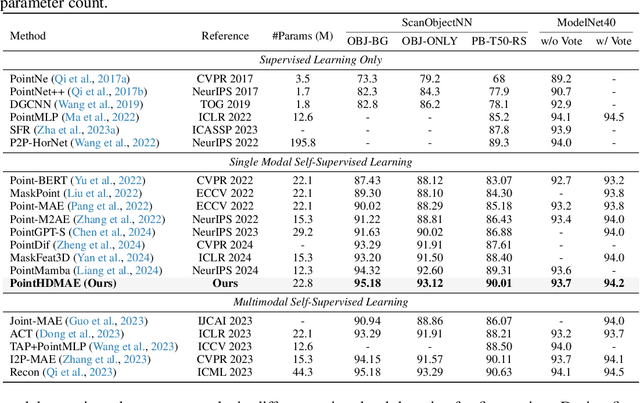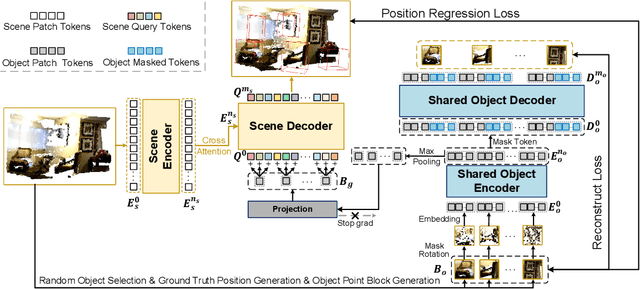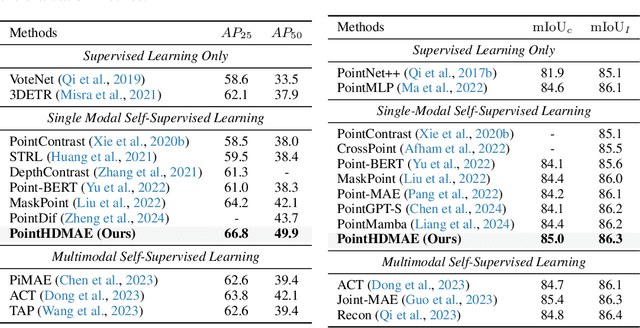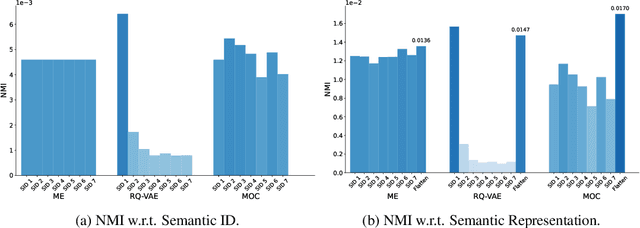Tao Dai
FastVAR: Linear Visual Autoregressive Modeling via Cached Token Pruning
Mar 30, 2025Abstract:Visual Autoregressive (VAR) modeling has gained popularity for its shift towards next-scale prediction. However, existing VAR paradigms process the entire token map at each scale step, leading to the complexity and runtime scaling dramatically with image resolution. To address this challenge, we propose FastVAR, a post-training acceleration method for efficient resolution scaling with VARs. Our key finding is that the majority of latency arises from the large-scale step where most tokens have already converged. Leveraging this observation, we develop the cached token pruning strategy that only forwards pivotal tokens for scale-specific modeling while using cached tokens from previous scale steps to restore the pruned slots. This significantly reduces the number of forwarded tokens and improves the efficiency at larger resolutions. Experiments show the proposed FastVAR can further speedup FlashAttention-accelerated VAR by 2.7$\times$ with negligible performance drop of <1%. We further extend FastVAR to zero-shot generation of higher resolution images. In particular, FastVAR can generate one 2K image with 15GB memory footprints in 1.5s on a single NVIDIA 3090 GPU. Code is available at https://github.com/csguoh/FastVAR.
Fence Theorem: Towards Dual-Objective Semantic-Structure Isolation in Preprocessing Phase for 3D Anomaly Detection
Mar 04, 2025Abstract:3D anomaly detection (AD) is prominent but difficult due to lacking a unified theoretical foundation for preprocessing design. We establish the Fence Theorem, formalizing preprocessing as a dual-objective semantic isolator: (1) mitigating cross-semantic interference to the greatest extent feasible and (2) confining anomaly judgments to aligned semantic spaces wherever viable, thereby establishing intra-semantic comparability. Any preprocessing approach achieves this goal through a two-stage process of Emantic-Division and Spatial-Constraints stage. Through systematic deconstruction, we theoretically and experimentally subsume existing preprocessing methods under this theorem via tripartite evidence: qualitative analyses, quantitative studies, and mathematical proofs. Guided by the Fence Theorem, we implement Patch3D, consisting of Patch-Cutting and Patch-Matching modules, to segment semantic spaces and consolidate similar ones while independently modeling normal features within each space. Experiments on Anomaly-ShapeNet and Real3D-AD with different settings demonstrate that progressively finer-grained semantic alignment in preprocessing directly enhances point-level AD accuracy, providing inverse validation of the theorem's causal logic.
FinTSB: A Comprehensive and Practical Benchmark for Financial Time Series Forecasting
Feb 26, 2025Abstract:Financial time series (FinTS) record the behavior of human-brain-augmented decision-making, capturing valuable historical information that can be leveraged for profitable investment strategies. Not surprisingly, this area has attracted considerable attention from researchers, who have proposed a wide range of methods based on various backbones. However, the evaluation of the area often exhibits three systemic limitations: 1. Failure to account for the full spectrum of stock movement patterns observed in dynamic financial markets. (Diversity Gap), 2. The absence of unified assessment protocols undermines the validity of cross-study performance comparisons. (Standardization Deficit), and 3. Neglect of critical market structure factors, resulting in inflated performance metrics that lack practical applicability. (Real-World Mismatch). Addressing these limitations, we propose FinTSB, a comprehensive and practical benchmark for financial time series forecasting (FinTSF). To increase the variety, we categorize movement patterns into four specific parts, tokenize and pre-process the data, and assess the data quality based on some sequence characteristics. To eliminate biases due to different evaluation settings, we standardize the metrics across three dimensions and build a user-friendly, lightweight pipeline incorporating methods from various backbones. To accurately simulate real-world trading scenarios and facilitate practical implementation, we extensively model various regulatory constraints, including transaction fees, among others. Finally, we conduct extensive experiments on FinTSB, highlighting key insights to guide model selection under varying market conditions. Overall, FinTSB provides researchers with a novel and comprehensive platform for improving and evaluating FinTSF methods. The code is available at https://github.com/TongjiFinLab/FinTSBenchmark.
Diffusion Prior Interpolation for Flexibility Real-World Face Super-Resolution
Dec 21, 2024Abstract:Diffusion models represent the state-of-the-art in generative modeling. Due to their high training costs, many works leverage pre-trained diffusion models' powerful representations for downstream tasks, such as face super-resolution (FSR), through fine-tuning or prior-based methods. However, relying solely on priors without supervised training makes it challenging to meet the pixel-level accuracy requirements of discrimination task. Although prior-based methods can achieve high fidelity and high-quality results, ensuring consistency remains a significant challenge. In this paper, we propose a masking strategy with strong and weak constraints and iterative refinement for real-world FSR, termed Diffusion Prior Interpolation (DPI). We introduce conditions and constraints on consistency by masking different sampling stages based on the structural characteristics of the face. Furthermore, we propose a condition Corrector (CRT) to establish a reciprocal posterior sampling process, enhancing FSR performance by mutual refinement of conditions and samples. DPI can balance consistency and diversity and can be seamlessly integrated into pre-trained models. In extensive experiments conducted on synthetic and real datasets, along with consistency validation in face recognition, DPI demonstrates superiority over SOTA FSR methods. The code is available at \url{https://github.com/JerryYann/DPI}.
MambaIRv2: Attentive State Space Restoration
Nov 22, 2024



Abstract:The Mamba-based image restoration backbones have recently demonstrated significant potential in balancing global reception and computational efficiency. However, the inherent causal modeling limitation of Mamba, where each token depends solely on its predecessors in the scanned sequence, restricts the full utilization of pixels across the image and thus presents new challenges in image restoration. In this work, we propose MambaIRv2, which equips Mamba with the non-causal modeling ability similar to ViTs to reach the attentive state space restoration model. Specifically, the proposed attentive state-space equation allows to attend beyond the scanned sequence and facilitate image unfolding with just one single scan. Moreover, we further introduce a semantic-guided neighboring mechanism to encourage interaction between distant but similar pixels. Extensive experiments show our MambaIRv2 outperforms SRFormer by \textbf{even 0.35dB} PSNR for lightweight SR even with \textbf{9.3\% less} parameters and suppresses HAT on classic SR by \textbf{up to 0.29dB}. Code is available at \url{https://github.com/csguoh/MambaIR}.
IntLoRA: Integral Low-rank Adaptation of Quantized Diffusion Models
Oct 29, 2024Abstract:Fine-tuning large-scale text-to-image diffusion models for various downstream tasks has yielded impressive results. However, the heavy computational burdens of tuning large models prevent personal customization. Recent advances have attempted to employ parameter-efficient fine-tuning (PEFT) techniques to adapt the floating-point (FP) or quantized pre-trained weights. Nonetheless, the adaptation parameters in existing works are still restricted to FP arithmetic, hindering hardware-friendly acceleration. In this work, we propose IntLoRA, to further push the efficiency limits by using integer type (INT) low-rank parameters to adapt the quantized diffusion models. By working in the integer arithmetic, our IntLoRA offers three key advantages: (i) for fine-tuning, the pre-trained weights are quantized, reducing memory usage; (ii) for storage, both pre-trained and low-rank weights are in INT which consumes less disk space; (iii) for inference, IntLoRA weights can be naturally merged into quantized pre-trained weights through efficient integer multiplication or bit-shifting, eliminating additional post-training quantization. Extensive experiments demonstrate that IntLoRA can achieve performance on par with or even superior to the vanilla LoRA, accompanied by significant efficiency improvements. Code is available at \url{https://github.com/csguoh/IntLoRA}.
BoostAdapter: Improving Vision-Language Test-Time Adaptation via Regional Bootstrapping
Oct 24, 2024



Abstract:Adaptation of pretrained vision-language models such as CLIP to various downstream tasks have raised great interest in recent researches. Previous works have proposed a variety of test-time adaptation (TTA) methods to achieve strong generalization without any knowledge of the target domain. However, existing training-required TTA approaches like TPT necessitate entropy minimization that involves large computational overhead, while training-free methods like TDA overlook the potential for information mining from the test samples themselves. In this paper, we break down the design of existing popular training-required and training-free TTA methods and bridge the gap between them within our framework. Specifically, we maintain a light-weight key-value memory for feature retrieval from instance-agnostic historical samples and instance-aware boosting samples. The historical samples are filtered from the testing data stream and serve to extract useful information from the target distribution, while the boosting samples are drawn from regional bootstrapping and capture the knowledge of the test sample itself. We theoretically justify the rationality behind our method and empirically verify its effectiveness on both the out-of-distribution and the cross-domain datasets, showcasing its applicability in real-world situations.
BoostAdapter: Improving Test-Time Adaptation via Regional Bootstrapping
Oct 20, 2024



Abstract:Adaptation of pretrained vision-language models such as CLIP to various downstream tasks have raised great interest in recent researches. Previous works have proposed a variety of test-time adaptation (TTA) methods to achieve strong generalization without any knowledge of the target domain. However, existing training-required TTA approaches like TPT necessitate entropy minimization that involves large computational overhead, while training-free methods like TDA overlook the potential for information mining from the test samples themselves. In this paper, we break down the design of existing popular training-required and training-free TTA methods and bridge the gap between them within our framework. Specifically, we maintain a light-weight key-value memory for feature retrieval from instance-agnostic historical samples and instance-aware boosting samples. The historical samples are filtered from the testing data stream and serve to extract useful information from the target distribution, while the boosting samples are drawn from regional bootstrapping and capture the knowledge of the test sample itself. We theoretically justify the rationality behind our method and empirically verify its effectiveness on both the out-of-distribution and the cross-domain datasets, showcasing its applicability in real-world situations.
Block-to-Scene Pre-training for Point Cloud Hybrid-Domain Masked Autoencoders
Oct 13, 2024



Abstract:Point clouds, as a primary representation of 3D data, can be categorized into scene domain point clouds and object domain point clouds based on the modeled content. Masked autoencoders (MAE) have become the mainstream paradigm in point clouds self-supervised learning. However, existing MAE-based methods are domain-specific, limiting the model's generalization. In this paper, we propose to pre-train a general Point cloud Hybrid-Domain Masked AutoEncoder (PointHDMAE) via a block-to-scene pre-training strategy. We first propose a hybrid-domain masked autoencoder consisting of an encoder and decoder belonging to the scene domain and object domain, respectively. The object domain encoder specializes in handling object point clouds and multiple shared object encoders assist the scene domain encoder in analyzing the scene point clouds. Furthermore, we propose a block-to-scene strategy to pre-train our hybrid-domain model. Specifically, we first randomly select point blocks within a scene and apply a set of transformations to convert each point block coordinates from the scene space to the object space. Then, we employ an object-level mask and reconstruction pipeline to recover the masked points of each block, enabling the object encoder to learn a universal object representation. Finally, we introduce a scene-level block position regression pipeline, which utilizes the blocks' features in the object space to regress these blocks' initial positions within the scene space, facilitating the learning of scene representations. Extensive experiments across different datasets and tasks demonstrate the generalization and superiority of our hybrid-domain model.
Towards Scalable Semantic Representation for Recommendation
Oct 12, 2024



Abstract:With recent advances in large language models (LLMs), there has been emerging numbers of research in developing Semantic IDs based on LLMs to enhance the performance of recommendation systems. However, the dimension of these embeddings needs to match that of the ID embedding in recommendation, which is usually much smaller than the original length. Such dimension compression results in inevitable losses in discriminability and dimension robustness of the LLM embeddings, which motivates us to scale up the semantic representation. In this paper, we propose Mixture-of-Codes, which first constructs multiple independent codebooks for LLM representation in the indexing stage, and then utilizes the Semantic Representation along with a fusion module for the downstream recommendation stage. Extensive analysis and experiments demonstrate that our method achieves superior discriminability and dimension robustness scalability, leading to the best scale-up performance in recommendations.
 Add to Chrome
Add to Chrome Add to Firefox
Add to Firefox Add to Edge
Add to Edge